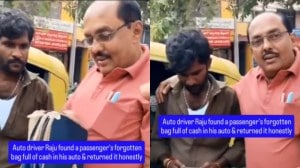Coalition cauldron: Action replay
The 2004 Lok Sabha results defied all predictions and underlined that India was,in the words of a commentator,a polity struggling to interpret its own meaning.....
The 2004 Lok Sabha results defied all predictions and underlined that India was,in the words of a commentator,a polity struggling to interpret its own meaning. That struggle only seems to have grown more acute in 2009. All the story-lines that were retrospectively read into Verdict 2004 were shortlived. There is no new nation-wide theme.
On one count,however,Elections 2004 appeared to make a long-term commitment: India seemed headed towards a two-coalition game at the Centre. There had been no clear mandate at the national level since the collapse of Congress dominance in 1989; regional parties had staked claim to their own piece of the Centre since the Third Front governments of the mid-90s. In 2004,after Sonia Gandhi took it upon herself to woo regional parties and was seen to do so too a tidying up of the political contest seemed imminent at the Centre.
In the states,the contest had already become broadly bi-polar over the last few decades. But state-level bi-polarisation had added up to fragmentation of the national party system. Since the competition wasnt between the same two parties in every state,a tangle of what political scientist E. Sridharan calls multiple bipolarities was thrown up at the Centre. In 2004,the Congresss emergence as coalition-maker appeared to initiate bi-polarisation at the Centre as well.
This hectic March,that process has been reversed and denied. After leading a coalition government for five years,the Congress has stepped back from its allies. Even lip service to coalition dharma,a part of the political conversation when the NDA became the first coalition government to complete a full-term at the Centre, has waned. A politics of contingent coalitions has taken its place.
Yet,looking back,the frank jostling by players for the best bargain in the run-up to Polls 2009 is not as unprecedented as it seems. The Congress may have changed its lines,but the script has not dramatically altered since 2004. Even then,alliances were made state to state,ideological considerations were secondary,and most alliances were tied up only at the last minute.
Last-minute alliances,political promiscuity
If political alliances look like they are being made on the run and without reference to party programmes in 2009,they looked the same way in 2004.
On February 2,2004,the Congress accepted the 10 seats the DMK offered it in Tamil Nadu; the DMK had recently broken away from the NDA along with the PMK and MDMK. (The PMK has just severed ties with the Congress while the MDMK pulled out of the UPA in 2007). The DMK-Congress-Left alliance against the BJP-AIADMK was the only state-level alliance that was finalised,including the allocation of seats,before the 13th Lok Sabha was dissolved on February 6. The last date for filing nominations was April 23.
In 2004,the NDA continued with its existing constituents except for parties that had broken away the DMK,MDMK,PMK in Tamil Nadu,INLD in Haryana,National Conference in J&K,Ram Vilas Paswans faction of the JD(U). But it was only by March 16 that the BJP and JD(U) agreed upon a seat-sharing pact for Bihar. The TDP and BJP reached a seat-sharing deal in Andhra Pradesh only by March 18.
The Congress and NCP reached a seat-sharing deal in Maharashtra along with three RPI factions and the JD(S) on March 20,just 10 days before the last date of filing nominations for the first round of voting in the state. On March 24,10 days before the last date for filing nominations for the first round of voting in the state,the Congress sealed the deal with the TRS in Andhra Pradesh.
The Bihar tie-up between the Congress,LJP,RJD,CPI(M) and NCP was announced on March 27 in 2004, barely four days before the last date for filing nominations for the first round of voting in the state.
If the TRS tie-up with the TDP in Andhra Pradesh looks opportunistic in 2009,given the TDPs staunch resistance to a separate Telangana, notwithstanding its recent somersault on the issue,the TRS-Congress pact in 2004 was equally shorn of ideological considerations. The Congress had long resisted division of the state.
The NCP retreated from its raison detre in 1999 opposition to Sonia Gandhis foreign origins to tie up with the Congress at the Centre in 2004. The Left entered into various state-level alliances with the Congress despite its stated differences on economic policy. Many parties that allied with the Congress in 2004 had tied up with the BJP in 1999 from the ARC in Arunachal Pradesh to the DMK in Tamil Nadu.
Differentiation of political calculations in different states
In 2004,too,state-level arithmetic had a life of its own,independent of the national math. In 2009,the JD(S),to take just one example,is at odds with the Left in Kerala,even as the two formations swear by their shared commitment to a non-Congress,non-BJP alternative elsewhere. Battlefield 2004 teemed with similar instances of wavering alliances blithely dropping or adding constituents as they crossed state boundaries.
The BJP-JD(U) alliance in Bihar in 2004 did not cross into Jharkhand where the BJP decided to go it alone. The Left was not a pre-poll ally of the Congress at the national level,but the CPI(M) tied up with it in Bihar and the CPI tied up with the Congress in Jharkhand. Both the CPI(M) and CPI tied up with the Congress in Andhra Pradesh,Tamil Nadu and Punjab,though in many seats of AP,candidates of the alliance partners contested against each other. The JMM tied up with the Congress in Jharkhand,but contested alone in Orissa.
The final score-card in 2004 explained the unevenness of pre-poll political calculations. The nation-wide vote shares of the two alliances were not uniformly spread across states. Even as it lost power at the Centre,the NDA gained votes in Rajasthan,MP,Maharashtra,Punjab and Kerala. The Congress vote share in UP and West Bengal and that of the BJP in Kerala,Haryana and J&K dipped way below their national averages. Verdict 2004 could not be interpreted at the national level; different states voted differently. Its a lesson players have carried into 2009.
Rise and fall of Congress as coalition-maker
The big story of 2009 is the Congresss retreat from coalition politics the party was initiated into in 2004.
On January 7,2004,the Congress set up a high-level team to work out pre-poll alliances with secular parties. Results of the Assembly elections in December 2003 in Rajasthan,Madhya Pradesh and Chhattisgarh had highlighted the power of small parties to play spoiler for the Congress. In MP,the BJP got only 3.5 per cent of the 9.2 swing against the Congress,the SP and Gondwana Ganatantra Parishad shared the rest. In Chhattisgarh,vote shares of the breakaway NCP led by VC Shukla and BSP were more than the gap between the Congress and BJP. The Pranab Mukherjee report on the Congress defeat in the 2003 Assembly elections in three states pointed out that the Congress needed alliances to win.
In Mumbai,December 2004,Sonia Gandhi spoke of an anti-BJP alliance. Later,the Congress chief would walk the talk,going across to talk to Paswan at his home or driving down to wish Mayawati on her birthday.
But in 2009,after leading a coalition government for five years,the Congress has taken a crucial step back from its role as coalition-maker. On January 29,the Congress Working Committee meeting decided that the party would enter into only state-specific,not national-level,alliances with UPA allies. This has rekindled suspicions of the partys discomfort with coalitions among many of its partners. It has also freed them up to bargain for the best deal.
The Congress manifesto of 2009 makes it clear that the party has come full circle on coalitions. These are national elections, it issues a stern reminder. While there will be regional,state-level and local issues that are important,these are elections for a government at the Centre,one that will govern all of India in its many diversities and fulfil its multitude of hopes and aspirations. It is only the Indian National Congress that is anchored in the larger vision of India as a nation,while at the same time being sensitive to regional and local sentiments.
The manifesto dwells on the achievements of the UPA in the last five years,but makes only a perfunctory mention of the fact that it was a coalition government. It does not dwell on coalition politics,or on the Congress view of it,at all.
Having run a coalition government for five years,the Congress could have highlighted its ability to lead a coalition as a necessary attribute in the coalition age. Or it could have pretended that coalition politics hasnt altered the game. That the Congress chose the latter option shows the distance travelled or not travelled since 2004. It also accounts for the more open nature of the contest in 2009.
Fronts: two,three…
In 2004,the political space outside of the Congress-led and BJP-led alliances was clearly defined: it consisted of the Left,BSP,SP,RLD. But the Left had pre-poll tie-ups with the Congress in several states; after the results were out,it offered outside support to the Congress-led government. So did the BSP and SP.
In 2009,after having loved and left the Congress,Left parties have become the pivot for a more open-ended third grouping of regional parties. They include the JD(S) (Congress ally in 2004),AIADMK (allied to the BJP in 2004),TRS (Congress ally in 2004),BJD (BJP ally till recently) and the BSP. But even parties currently allied to the Congress and BJP are being seen as potential crossovers to a post-poll Third Front.
Political churning,entry of new players
The debut of new players in 2009 shows that the ferment in Indian politics that characterised the 1990s is not yet over.
Two new political parties have just been allotted election symbols by the Election Commission. The DMDK,launched by actor Vijayakanth in Tamil Nadu,is poised to go to the people with the nagada as its symbol.
In Andhra Pradesh,megastar Chiranjeevis Praja Rajyam Party has been allotted the train engine. The PRP has injected a new uncertainty in what was essentially a two-horse race in the state.


- 01
- 02
- 03
- 04
- 05





























